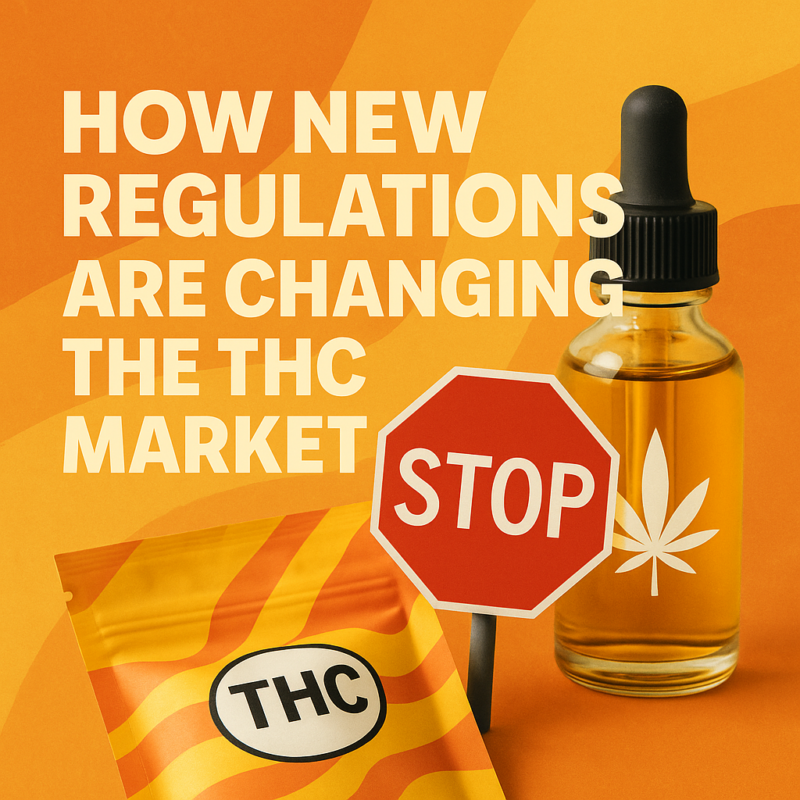
An Educational Look at the Evolving Landscape
Introduction
Over the past decade, the legal THC market has expanded rapidly across the United States and parts of the world. As public opinion shifted and state-level legalization spread, the cannabis industry saw record growth in products, brands, and consumers. However, 2024 and 2025 have brought a new wave of regulation that is reshaping how THC is produced, marketed, and sold.
This article explores how these regulations are impacting businesses and consumers alike, offering a clear overview of key changes in the cannabis space—from product reformulations to packaging laws and delivery restrictions.
1. Standardization at the State Level
One of the most significant developments in the THC market is the push toward standardized state-level frameworks. While federal legalization has yet to happen in the U.S., many states are taking action by tightening rules on THC production, distribution, and testing.
For example, in Minnesota, recent regulations require all licensed THC retailers to adopt seed-to-sale tracking systems and submit products for third-party lab testing. These requirements aim to ensure consumer safety, reduce contamination, and build trust in the market.
Brands that once operated in looser “gray areas” are now required to meet strict standards, resulting in product reformulations, labeling updates, and more controlled supply chains.
2. Closing the Hemp-Derived Loophole
Another major change is the crackdown on hemp-derived cannabinoids, particularly Delta-8 and Delta-10 THC. These compounds are psychoactive but were often sold legally in non-cannabis states due to their origin in federally legal hemp.
However, new regulations in states like Tennessee and Georgia now ban synthetically derived cannabinoids, even if they come from hemp. These rules aim to reduce unregulated sales and bring all psychoactive products under the same umbrella as traditional cannabis laws.
As a result, companies that relied on hemp-derived THC are being forced to pivot—often toward wellness-based, non-intoxicating product lines like topicals, CBD tinctures, or adaptogen blends.
3. New Packaging & Labeling Rules
In response to concerns about child safety, overconsumption, and misleading marketing, many states are implementing stricter rules on how THC products are packaged and labeled.
Some examples include:
- Plain packaging requirements (similar to tobacco laws)
- Restrictions on cartoon characters or bright colors
- Clear labeling of THC content per dose and per package
- QR codes linking to lab results or ingredients
These changes impact both brand aesthetics and marketing strategies. While some businesses may lose visual flair, the industry is shifting toward transparency, compliance, and educational packaging that supports safer use.
4. Delivery, Retail, and Access Regulation
Access to THC products is also changing due to new rules around delivery services, licensing, and retail structure.
Some states are banning vertical integration, requiring brands to operate separately as growers, manufacturers, or retailers. Others are opening up micro-license opportunities for small businesses, social equity applicants, and independent operators.
Meanwhile, delivery rules are tightening, with states requiring:
- Real-time age verification
- GPS tracking of drivers
- Secure handoff protocols
These rules aim to balance access with security but may increase operating costs for smaller THC businesses and delivery startups.
5. Why These Changes Matter for Consumers
For everyday cannabis users, these regulations may seem like background noise—but they affect the products you buy, how they’re labeled, and even where you can access them.
Here’s how consumers are directly impacted:
- Improved safety: More lab-tested products mean fewer contaminants.
- Clearer information: New labels help prevent accidental overconsumption.
- Higher quality: Brands that comply are often investing in better formulations and ingredients.
- Limited access in some areas: Delivery or retail restrictions could affect availability depending on your state.
Being an informed consumer means understanding these changes and choosing brands that meet or exceed regulatory standards.
6. Lessons for the Industry
For businesses in the THC space, this regulatory wave highlights the importance of:
- Staying flexible in the face of legal changes
- Investing in compliance infrastructure early
- Using transparency as a competitive advantage
- Building consumer trust through responsible marketing
Brands that can adapt to these evolving rules are more likely to survive—and even thrive—in a maturing market.
Conclusion
The THC market is no longer the wild west. New regulations are bringing structure, safety, and oversight to a growing industry. While these changes may feel challenging at first, they also offer an opportunity: to raise standards, protect consumers, and build a stronger, more sustainable future for cannabis.
As a consumer or brand, staying informed is the first step. As we move deeper into 2025, the question isn’t whether regulations will shape the market—but how wisely the industry chooses to evolve in response.